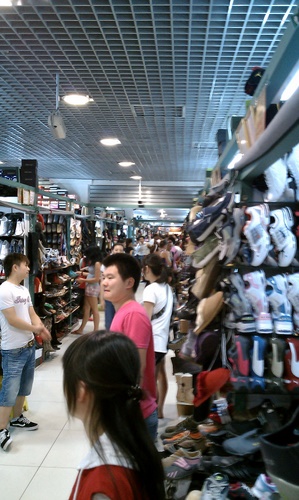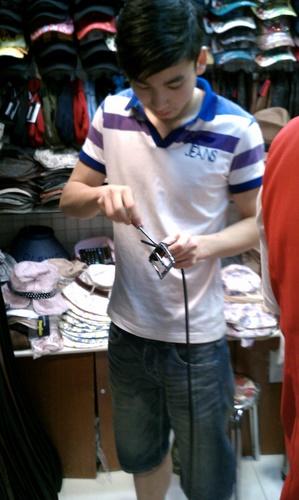The second part of my great last day took place at the Silk Street market. At one point, if you had asked me if the market was a must-see place for travelers going to Beijing, I would have told you that it’s interesting, but not that great. After visiting the market this time, I would say that it’s a great experience and you should go. I recommend spending a couple hours there, especially if you aren’t tired from walking for hours before you get there.
The Silk Street market is a multi-story version of a street market. Inside you will find every type of Chinese souvenir that you could possibly want—fans, statuettes, key chains, t-shirts, etc. The market is also well-known among tourists as a good place to buy false luxury brand goods including clothing, electronic goods and jewelry. You can purchase tailor-made suits, custom-fit and ready to pick up within three days. You pick out the material you want, get measured and the suit will be ready in three days. Be sure to not pay more than half up front in order to make sure that the suit is ready when you come back. Express orders can be made, for a price.
When you go to the market, be sure to bargain hard. The vendors won’t sell you anything at a loss, so don’t feel bad about walking away after offering a price that seems ridiculously low. You will be called back if they can make even a little money. The next stall has the same stuff and each vendor is under intense pressure to survive. The game can be fun, and it is easy to spend hours there if you enjoy negotiating.
As you walk in the front door of the market, there is a large red sign that gives you a general idea of what is sold on each floor. These are useful if you know what you’re looking for. If not, it’s fun to just wander into the aisles and just get a feel for the market. You can use the elevators near the main entrance to change floors and there are also escalators in the center of the market.
 The shoe departmentAs you enter, be prepared for sales pitches. To your left and to your right, lines of vendors (mostly women) wearing red vests call out to you, hoping to catch your attention. “Hello! You looking for a watch?” “Excuse me sir, would you like a jacket? Please, come take a look!” “Come, buy a silk dress for your girlfriend! You need to be nice to your girlfriend!” and so on. Don’t be afraid to say no. They’ve heard it before.
The shoe departmentAs you enter, be prepared for sales pitches. To your left and to your right, lines of vendors (mostly women) wearing red vests call out to you, hoping to catch your attention. “Hello! You looking for a watch?” “Excuse me sir, would you like a jacket? Please, come take a look!” “Come, buy a silk dress for your girlfriend! You need to be nice to your girlfriend!” and so on. Don’t be afraid to say no. They’ve heard it before.
One thing that you realize quickly is that you are in a “buyer’s” market. There are so many stalls that have the same stuff. I don’t know if each stall is independently run or how the compensation works, but I do know that if you decide you don’t like someone’s prices or quality, you can go elsewhere easily. This is important to remember when you do finally see something that you want to buy. If you can bargain from a position of strength, you won’t get ripped off too badly.
The biggest disadvantage you have as a buyer, especially for first time visitors, is that you probably have no idea what prices are reasonable. Most of the brand name stuff you buy at the Silk Market is fake, but the quality can be pretty good. The question becomes: what are you willing to pay? Above all, you don’t want to walk away feeling like you got ripped off (at least that’s my biggest fear). Therefore, when you pick something out to buy and ask how much they want, don’t be surprised if you hear a number that is much higher than you were expecting. I’ll give you my story as an example.
I went to the market intending to buy three things: a belt, a silk pajama for my daughter and a couple business card holders. I ended up finding the card holders first. I was passing by a booth slowly, not seeing anything I wanted. the girl asked me what I wanted and (proudly) I was able to answer in Chinese. She brought me over to a cabinet and pulled out a piece of junk that was kind of dirty, paint falling off the back, saying she wanted 150 Yuan (over $20) for it. I told her no way (If you’re going to try to cheat me, at least do it with something worth getting cheated over…come on!)
She pointed me towards another style that was nicer. They had (fake?) mother-of-pearl inlaid covers and the metal was a better quality. For each of these she wanted 350 Yuan. That’s over $50! Fifty dollars! No no no no! Tai gui le! (Too expensive!). She looked offended, then asked my price. In Chinese, I stuttered that I wanted two and my price was 100 Yuan. For both. She said be serious. I am. No, really. Really, that’s what price I can pay today. If you don’t like the price, no problem, but I can’t pay more today. You say that‘s only what you can pay today, but what about tomorrow? Tomorrow I’m going home!
I then walked away as she yelled “what’s your best price?” I told you! A couple steps later, she called me back—okay, come back, 100. I went back and paid her. The girl at the next stall was laughing. She said something to me that I think was a compliment about my negotiations. In reality, I probably still paid too much. Had I really worked hard, I could have gotten a lower price, but the bargaining was fun and I didn’t walk away feeling like I got ripped off. One victory for me.
The pajama was next and it went pretty much the same way. I found that the little Chinese I can speak was very useful. I could negotiate using Chinese numbers and it also helped me develop a rapport with the vendor and the vendor’s neighbors, which added to everyone’s entertainment.
The belt was the last, and of the three, the most fun. With my confidence boosted by the first two negotiations, I was looking forward to this one. Entering a stall, the guy working there showed me his selection. There were lots of luxury brands on the right side of the rack and towards the left side were the cheaper belts. There were black, brown and red belts, belts with big garish buckles, some with rhinestones—whatever you might want. I was just looking for a black leather belt with a normal buckle to replace the one I had worn out over the last five years.
I picked out a Bally belt (surely it was authentic) off the rack and asked him how much he wanted for it. 250 Yuan. 250, are you joking? How much do you want to pay? I told him fifty. Fifty!? He pointed to a belt at the left end of the rack and said that’s what I could get for 50. After holding it, I wouldn’t have paid ten Yuan for it.
I offered him 70 for the Bally belt. Be serious, he said. I am, I replied. He said how about 150? Seventy. I started walking away. He grabbed my arm and asked, what’s your best price? Qi shi (seventy) I repeated. Best price? Seventy. Best price? Seventy. He asked a few more times, receiving the same response each time. The other vendors were laughing by now. Come on, what’s your real best price? That is my best price. He paused, and I knew he was going to give in. Okay, he said, seventy.
After I paid him, I checked the size of the belt. It was too big. You want me to shorten it for you, he asked. Uh oh, here we go again, I thought. I’ll do it, he said, but you have to buy me an ice cream, pointing towards the small market just beyond the next aisle. Deal! I laughed, and scooted off to the market while he shortened the belt. The guy ended up having to shorten the belt three times, so I got my ice cream’s worth out of him. I’m not sure if 70 Yuan was a good price for the belt, but the story and the entertainment value were worth at least half that.
 That will be one ice cream, please. . .
That will be one ice cream, please. . .
I thanked him and made my way back to the subway. By the time I got back to BLCU at 5:00, I was tired, sweaty and dirty, but happy from the day’s good fortune. I never did make it to get that haircut, but now I will have something to do on the next trip to Beijing. . .